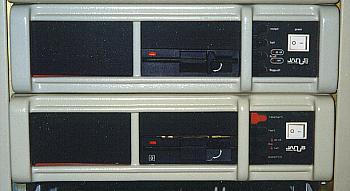The TPA-11/110 is a dual-processor (well, multiprocessor really) system, a joint venture of the KFKI and the soviet company "Elektronika". A qbus machine, its main processor is the 16-bit NR5180 LSI-11 CPU, the parallel processors are Z80's. It could run the PDP-11 OS's and CP/M too, hence the name "Janus" (Janus was a roman god with two faces, one looking into the past and the other to the future).
The computer itself was housed in a BA23-type enclosure, it was mainly used as the console for the TPA-11/580 system.
Configuration:
- NR5180A 16-bit processor
- NR5181A 8-bit processor
- NR581A minidisk floppy formatter
A quad-height LSI-11-class processor board based on the Elektronika MC1201.01, with the one-chip PDP-11 CPU, 32 KW RAM, a 9600-baud asynchronous serial line, parallel printer line, RX01-compatible floppy interface and bootstrap PROM.
A double-height board with Z80 CPU (3.5 MHz clock), 62 KB DRAM, 2KB EPROM
(Interesting to note that the Z80 was copied and manufactured in many places behind the Iron Curtain, like the Soviet Union, East Germany and Hungary. Engineers have disassembled many dozens of Zilog IC's until they could clone it. The MMV factory (Hungarian Microelectronics Company, Budapest) produced Z80's for years until the FAB was went up in flames under misterious circumstances...)
This board had its own RAM, and it communicates with the qbus via buffered registers.
Another dual-height board that only draws current from the qbus, electronically it sits between the NR5180A processor's RX01 floppy interface and the 5.25 floppy drive in the BA23. It interfaces the 5.25 FD's as RX01's to the CPU. The card contains a Z80, 2KB EPROM, 1KB RAM and a WDC1793 FDC.
- NR5287A drawer (equivalent of the Digital BA23):
- Front panel:
eight quad-size qbus slots, with metric connectors (DEC cards can only be used with card adapters)
two 5.25" floppy drives (400 KB each)
switches: power ON/OFF, restart, halt, LTC (line time clock), wwprot
LED's: DCOK, RUN
